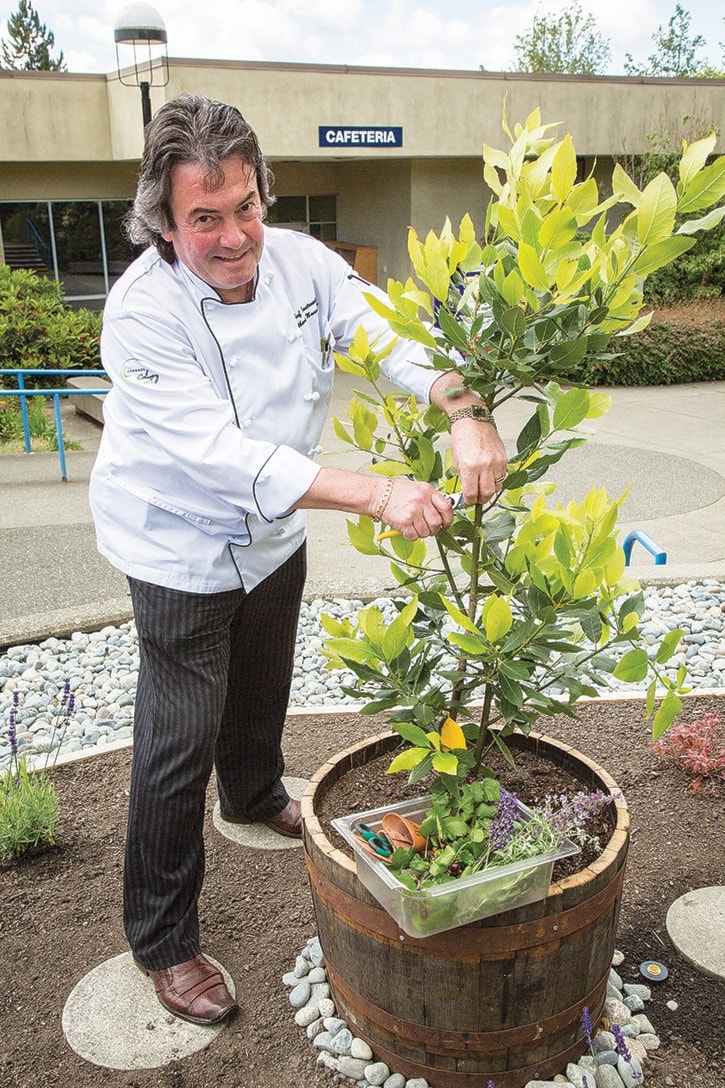Recent visitors to Camosun College’s Interurban campus may have noticed a small yet striking new feature next to the Culinary Arts Centre. With neatly arranged rows of electric blue porcelain pots, a winding path of circular stepping stones and lovingly tended patches of delicious herbs, Camosun’s new ‘edible garden’ is designed to help students in the professional cook program integrate fresh, local ingredients into their cooking.
“The vision is to have it really accessible,“ says Camosun’s Culinary Arts chair Gilbert Noussitou. “Close to the cafeteria, the garden is easy to get into without having to put your boots on.”
Noussitou’s experience in culinary arts spans over four decades. He has worked at some of the finest establishments in France, England and Canada and he is a graduate of the prestigious L’École Hôtelière Des Pyrénées in Toulouse, France. He has taught at Camosun since 1987.
Throughout his career, he has always believed in the essential connection between food and the land. “Using local ingredients is definitely something we try as much as we can in our program,” he says, noting that the positive trend towards ‘eating local’ requires a better understanding of how that can be achieved.
“I think that the educational component on food in general is really lacking nowadays,” he says. “There is a whole generation that has grown up expecting the food to be at the supermarket. We’re finally going back now to learning how and where our food grows.”
The edible garden is a key step in that direction. Camosun’s facilities team started planning it about a year and a half ago and when the budget was approved for an irrigation system, it became a viable project.
“Right now we’ve planted tarragon, chives, sage, oregano, lavender, blueberry bush, salmonberry bush, laurel, and a few others,” he says. “We’re starting with perennial plants that don’t have to be replanted every year, and are easy to care for.”
The garden is not only useful, but is visual impact is designed to inspire. “I think the looks are part of the whole experience. It’s like eating: when a plate of food looks good you want to eat it and you’re going to enjoy it more. I think a garden is the same.”
He hopes that this appealing vision will motivate his students while they cook. “Picking herbs from a beautiful garden is much more attractive and much more present. When you get back to the kitchen, you still have that image of that beautiful garden that you just picked from.”
As much as possible, Noussitou strives to connect his students with local food producers. ”Through the local markets, we’re trying to get our students connected to the product itself.” For advanced students, tours of farms, wineries and cheeseries are part of the curriculum. Local producers are often happy to give presentations to his classes, inspiring ideas for future dishes.
And with the wealth of local food options available on the South Island, the opportunities for anyone to cook with fresh and local ingredients are increasing. >
“Pork is one of my favourite meats,” says Noussitou. “There are a few pork growers in Metchosin and in Saanich with a great breed of pork that produces better meat. Local corn is coming up in season now. I love grilled corn. Methosin has beautiful lamb. Fish of course, and all kinds of vegetables – last weekend I cooked a big pot of green peas at home just for my wife and I. We finished it all, it was great.”
Noussitou has big plans for the edible garden. “We are already talking about growing it, expanding it,” he says enthusiastically. “Right now, we are working on developing some information cards that we are going to put in front of each of the herbs telling people what it is, how to pick it without damaging the plant, and what can be done with it on the cooking side of things.”
As it evolves, he hopes the garden becomes both a campus and a community resource. “We’ve seen some herbs that have just disappeared because somebody has said: ‘well I need some of that for my supper,’ okay great, just respect the plant, that’s all we ask.”
Rosemary - “Rosemary is a very old herb that is quite powerful and potent. It can be used with a lot of things as long as it’s used sparingly. The things that come to mind are white meats such as chicken and pork, but it also can be used with lamb. Rosemary and lamb is a very popular one and roast beef and rosemary as well. “
Savory - “Savory is a bit of a forgotten herb. It is used a lot in soups and sauces with lighter flavoured items – with fish it would be great. Using it with potatoes and any of the root vegetables is a wonderful combination.”
Lavender - “A bit like rosemary, lavender is quite powerful. The thing that comes to mind is lavender ice cream. It is an odd one in terms of flavour, but properly measured, it’s a wonderful treat.”
